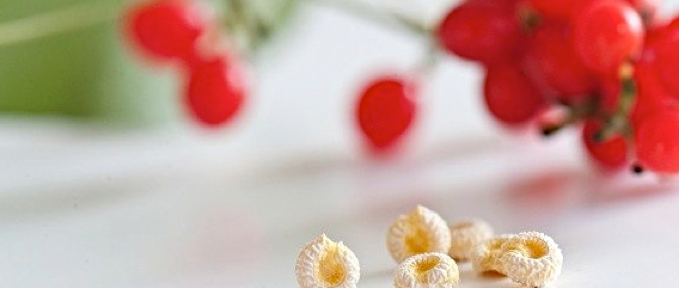As I have been poking around Nacogdoches during the last couple of weeks, I’ve noticed that fruits and berries have begun to ripen on our trees and shrubs. Have you noticed?
The plant that really got me thinking was Cocculus carolinus. Cocculus referring to a berry and carolinus, of course, from Carolina, thus little Carolina berry. Well, I’ve planted a number of these plants along my fence where they’ve grown up and have begun to bear fruit. I’ve also planted one on a telephone pole. It’s now about twenty feet in the air and bright red berries have appeared all along the vine. Have I mentioned it is a vine?
Cocculus carolinus is a deciduous twining vine with attractive, heart-shaped, summer foliage. But, its real attraction is its bright red fruit or berries in the fall of the year. This brings me to one of the plant’s other common names. It is sometimes called Carolina Snailseed. Inside each berry there’s a tiny seed; and as its name implies, the seed looks very much like a snail or like some kind of miniscule, fossilized, prehistoric nautilus.
Now this Snailseed vine is a native to East Texas. It’s a plant that birds are attracted to because of its bright red berry. It’s not uncommon in our woods and periodically birds will ‘plant it’ amidst our shrubbery where the vine will grow and intertwine among our ornamental shrubbery. Under the right circumstances- running over an arbor or over a trellis or up a fence- it can be quite handsome, especially in the fall of the year. Like now.
Plants sometimes need an advocate. I’ve once considered Cocculus carolinus as a pest because some of my garden customers wanted me to pull it out of their azalea beds. I personally didn’t mind the vine, but they considered my carefree disposition towards it as laziness. There were, in my way of thinking, more important things for me to do. So, somewhere in the back of my mind I resented Snailseed because it got me into conflict and at odds with my clients.
Well, a number of years ago, I was walking around the historic district of Nacogdoches with Greg Grant. We were talking history and plants, of course, when we came across a large wooden fence with azaleas planted in front of it; and, somehow or another, Snailseed had worked its way up through the fence and that fall had covered itself in bright red berries. Greg grabbed a few of the little berries from the vine and promptly popped them in his mouth, sucking off the pulp and separating it from the seed (much like a baseball player separates sunflower seeds from its hull). He spit out the pulp and then spit out the tiny little seeds onto his hand saying, “Look.” There in the palm of his hand were little seeds that looked exactly like snails. “How cool,” I thought. If you have children around and a few Snailseed vines, this would be a wonderful, fascinating way to engage a child’s interest in things botanical. Folks always need someway to engage with the natural world.This little vine was never the same in my mind after Greg’s demonstration. I was won over in an instant.
As the Snailseed vine climbs its way up the telephone pole by my house, I think of Greg’s horticultural demonstration and how in each one of those bright red berries lies a nautilus sleeping quietly.

